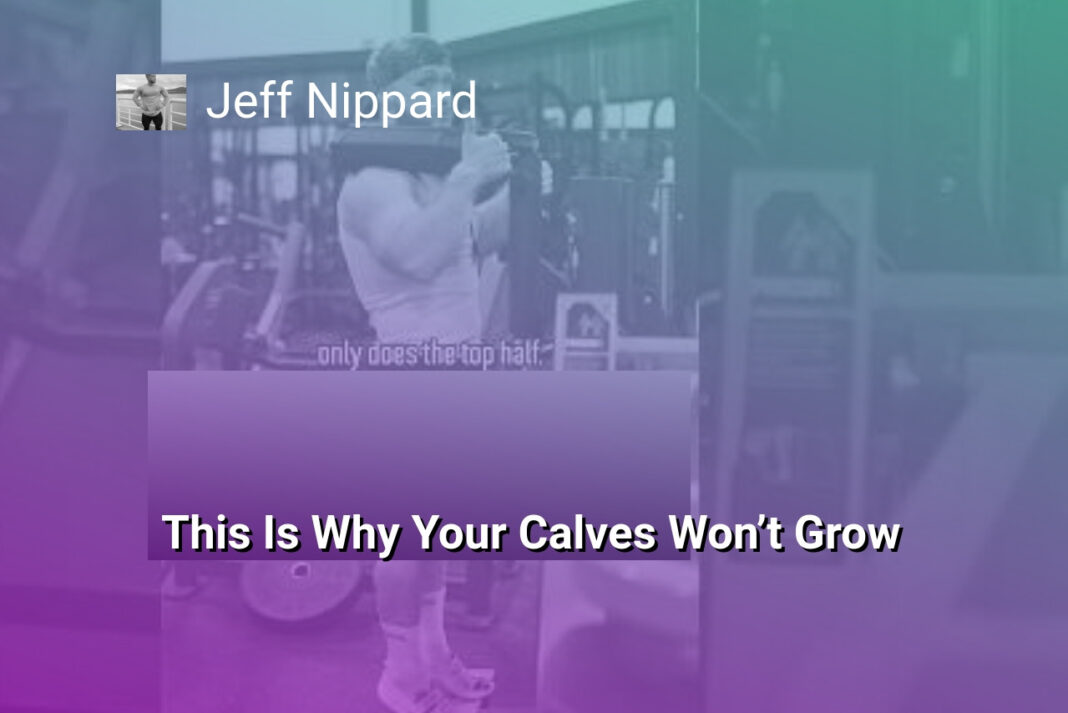The Bottom Line:
- In this text, the author discusses the effectiveness of different calf-raising techniques in promoting calf muscle growth. The author highlights that neither a full range of motion nor half-reps in the top half of the movement led to significant calf growth.
- However, the author discovered a third technique that resulted in about twice the calf growth compared to the other two methods. This technique involves staying in the bottom, stretched position of the calf raise without fully going up onto the toes.
- The author explains that this bottom-half calf raise technique is more effective because it keeps the calf muscles under constant tension and stretch, which is crucial for muscle growth.
- The author also notes that this method allows for the use of additional weight, as long as the negative (lowering) portion of the movement is controlled.
- The author recommends this bottom-half calf raise technique as a more effective way to train the calves and achieve greater muscle growth, compared to the traditional full range of motion or half-rep approaches.
The Myth of Full Range of Motion Calf Raises
Debunking the Calf Raise Myth
Many fitness enthusiasts believe that performing calf raises with a full range of motion is the key to maximizing calf growth. However, recent research has challenged this long-held belief. The study found that neither the full range of motion group nor the half-rep group experienced significant calf growth after 8 weeks of training.
The Surprising Technique That Works
The study went on to uncover a third technique that produced nearly twice the calf growth compared to the other two methods. This technique involved performing calf raises without going up onto the toes at all. Instead, the participants focused on staying in the stretched bottom half of the movement, where the calves are under the most tension.
The Importance of Calf Stretching
The findings suggest that the key to calf growth lies not in the full range of motion, but in the bottom, stretched position of the exercise. By avoiding the top portion of the movement and focusing on the stretched position, the calves are subjected to a greater degree of muscle fiber activation and time under tension, which are crucial factors for hypertrophy.
This technique, while counterintuitive to the traditional calf raise, allows the calves to work through a more optimal range of motion and places greater emphasis on the eccentric (lowering) phase of the movement. The eccentric contraction is known to be a powerful stimulus for muscle growth, and by staying in the stretched position, the calves are able to experience a more intense eccentric load.
Furthermore, the study suggests that the full range of motion calf raise may not be as effective as previously thought. The researchers hypothesize that the top portion of the movement, where the calves are in a shortened position, may not provide the same level of muscle fiber activation and tension as the stretched bottom position.
In conclusion, the findings of this study challenge the long-held belief that a full range of motion is necessary for calf growth. Instead, the research suggests that focusing on the stretched bottom position of the calf raise, without going up onto the toes, may be a more effective technique for maximizing calf muscle development.
The Limitations of Half Reps in the Top Half
Exploring the Limitations of Half Reps in the Top Half
The study revealed that performing half-range calf raises, where individuals only worked the top half of the movement by staying up on their toes, did not lead to significant calf growth. This finding challenges the common belief that focusing on the contracted, or “peak,” portion of the exercise is the key to maximizing calf development.
The Importance of Full Range of Motion
While the group that utilized a full range of motion saw slightly more growth compared to the half-rep group, the difference was not substantial. This suggests that simply going through a complete range of motion is not enough to optimize calf muscle development on its own.
The Surprising Technique That Unlocked Significant Gains
The researchers then discovered a third technique that led to approximately twice the calf growth compared to the other two approaches. This technique involved avoiding the top portion of the movement altogether and instead focusing solely on the bottom, stretched position of the calf raise. By staying in the bottom half of the movement and not fully contracting the calves, the participants were able to stimulate significantly more muscle growth.
The findings from this study challenge the conventional wisdom that the peak, or contracted, portion of an exercise is the most important for muscle development. Instead, they suggest that targeting the stretched, or lengthened, position of the calf raise may be the key to unlocking greater calf growth. This technique, which involves avoiding the top half of the movement and instead focusing on the bottom, stretched position, appears to be a more effective approach for maximizing calf muscle development.
The Surprising Technique That Doubles Calf Growth
Unlocking the Power of the Stretched Calf Muscle
Contrary to popular belief, the key to maximizing calf growth lies not in the full range of motion or the top half of the movement, but rather in the often-overlooked bottom half. A recent study has revealed a surprising technique that can effectively double calf growth, and it all comes down to maintaining the stretch in the calf muscle.
The Limitations of Traditional Calf Raises
The study found that traditional calf raises, where individuals fully extend their calves up onto their toes, did not result in significant growth. Similarly, the group that performed only the top half of the movement, staying in the contracted position, also saw minimal gains. This suggests that the common approach of focusing on the peak contraction may not be the most effective strategy for calf development.
The Transformative Power of the Stretched Calf
The real breakthrough came when the researchers introduced a third technique that involved staying in the bottom, stretched position of the calf raise. By avoiding the full extension onto the toes and instead rotating on the balls of the feet, the participants were able to keep their calves under constant tension and in a state of stretch. This simple yet effective modification led to nearly double the growth compared to the other two groups.
The reason for this dramatic difference lies in the physiological response of the calf muscle. When the muscle is kept in a stretched position, it triggers a cascade of anabolic processes that promote muscle growth. This includes the activation of satellite cells, which are responsible for repairing and rebuilding muscle fibers, as well as the increased production of growth factors that stimulate hypertrophy.
By focusing on the bottom half of the movement and maintaining the stretch, individuals can tap into this powerful growth-stimulating mechanism and unlock their calf’s full potential. It’s a simple yet transformative technique that can revolutionize your calf training and take your lower leg development to new heights.
Staying in the Stretched Bottom Half for Stronger Calves
The Power of the Stretched Calf Muscle
Contrary to the common belief that full range of motion is the key to calf growth, a new study has revealed a surprising technique that can significantly boost your calf development. The researchers found that staying in the stretched bottom half of the calf raise movement, without fully extending up onto the toes, can lead to almost twice the muscle growth compared to traditional full range of motion or partial range of motion exercises.
The Science Behind the Stretch
The reason this technique is so effective lies in the biomechanics of the calf muscle. When the calf is in the stretched position at the bottom of the movement, the muscle fibers are under greater tension and stress, which is a key stimulus for muscle growth. By maintaining this stretched position and avoiding the top half of the movement, you’re keeping the calf muscle under constant tension, rather than allowing it to relax at the top of the rep.
Implementing the Stretched Calf Raise
To incorporate this technique into your calf training, simply perform your calf raises by lowering down until you feel a deep stretch in the calves, but avoid going all the way up onto your toes. Instead, focus on controlling the negative portion of the movement and rotating on the balls of your feet, rather than fully extending. You can still add weight to these exercises to increase the challenge, but the key is to keep the calf muscle under tension throughout the entire range of motion.
By prioritizing the stretched position and avoiding the top half of the movement, you’ll be able to stimulate your calf muscles in a way that traditional calf raises simply can’t match. This technique may take some getting used to, but the results in terms of calf growth and development are well worth the effort.
Implementing the Effective Calf Training Technique
Focusing on the Stretched Position: The Key to Calf Growth
The study findings reveal a surprising insight into the most effective calf training technique. Contrary to the common practice of performing full range of motion calf raises or limiting the movement to the top half, the researchers discovered that the key to significant calf growth lies in focusing on the stretched position at the bottom of the movement.
Avoiding the Toe-Up Position
The study participants who avoided going up onto their toes and instead concentrated on the bottom, stretched portion of the calf raise exercise experienced nearly twice the muscle growth compared to the other groups. This suggests that the traditional approach of fully extending the calves by rising up onto the toes may not be the most effective strategy for maximizing calf development.
Embracing the Controlled Negative
By staying in the stretched position and avoiding the toe-up position, the participants were able to better target the calf muscles throughout the entire range of motion. Additionally, the researchers noted that the participants in this group were able to handle heavier loads, as the stretched position at the bottom of the movement requires greater muscular engagement and control. This emphasis on the controlled negative portion of the exercise appears to be a key factor in stimulating significant calf growth.





